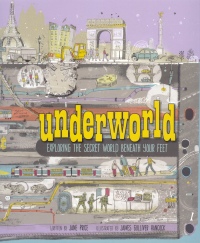| ________________
CM . . .
. Volume XXI Number 6. . . .October 10, 2014
excerpt:
Faith McNulty’s How to Dig a Hole to the Other Side of the World and Peter Kent’s Hidden Under the Ground: The World Beneath Your Feet are two books for children that I have recommended to future teachers who will be teaching about the interior of Earth. Now there is a third: Jane Price’s Underworld: Exploring the Secret World Beneath Your Feet. As the above excepts from the book suggest, Price writes about “Earth’s crust and below.” Several of the pages of the book look at Earth’s structure and geological events, but the majority of the 96 pages draw attention to how animals and humans have used and continue to use the top 3.9 km of the crust and the gems and treasures found when digging holes, exploring caves, or mining. Underworld is composed of nine chapters with titles ranging from “Dead and buried: Into the ground you go” to “Hide and seek: Dig deep and keep quiet.” Price begins the book with information on the internal layers of Earth, volcanoes, and fossils. She then helps readers to understand how caves are formed, where Earth’s oldest, longest, and deepest caves are located, and how crystals form. In her description of caves, she also uses two pages to describe the Paleolithic paintings discovered in the Lascaux Cave in France and two pages to present the 200 underground cities in Cappadocia, Turkey, that were carved out of rock by early Christians hiding from the Roman army. Chapter 3 is focused on animals, including beetles, snakes, and Prairie Dogs that live part of their lives underground in burrows or dens, and animals, called trogloxenes, troglophiles and troglobites, that love the dark that caves provide. Most interesting of these are the troglobites that are so adapted to living in the absence of light that they often have no eyes or pigment. From underground habitats, Price moves on to human burials with a focus on the tombs of Egyptian pharaohs, the 7000+ life-size terra-cotta soldiers buried in 210 BCE with the First Qin emperor and unifier of China, and the barrow burial of a warrior, possibly the High King of England, in a longboat at Sutton Hoo in Suffolk. She also sets aside two pages to tell readers about the Mexican Day of the Dead, group burial mounds vs. coffins, gravestones and markers, vampires, and body snatchers. Chapter 5 is about the buried treasure of pirates, castle dungeons, the trenches of World War I, and underground bunkers, while Chapter 6 focuses on mining and the excavation of coal and precious minerals and gems. Price also includes an informative description of the 2010 rescue of the 33 Chilean coal miners who were trapped 700 m below ground for 69 days. She describes the hidden world under Paris in Chapter 7 and Tokyo’s underground in Chapter 8. Readers will be surprised to learn of the Parisian catacombs and Paris’ 2000 km of sewers as well as the Star Wars like sci-fi city and 1000 m2 subterranean farm with rice paddies under the streets of Japan’s largest city. The book’s final chapter is about human use of the underworld in the future. In the eight pages of this chapter, Price explains the research scientists are carrying out underground and why they require absolute silence and isolation for this work. She also looks at mega-bunkers and underground cities built as war shelters for leaders of nations to protect these government officials and their families from nuclear missiles. Oddly, the chapter ends with a description of the seed vault in arctic Norway that could be used to begin again if we destroy our own planet and manage to make it to Mars with nuclear-powered tunneling machines that enable us to live underground away from the lethal Martian atmosphere.
Highly Recommended. Barbara McMillan is a teacher educator and a professor of science education in the Faculty of Education, the University of Manitoba.
To comment
on this title or this review, send mail to cm@umanitoba.ca.
Copyright © the Manitoba Library Association. Reproduction for personal
use is permitted only if this copyright notice is maintained. Any
other reproduction is prohibited without permission.
Next Review
| Table of Contents For This Issue - October 10, 2014. |
